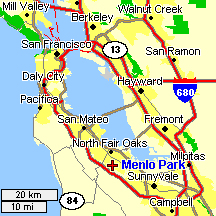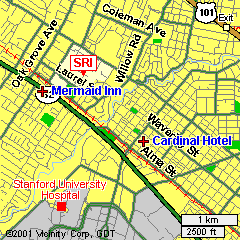I'm neither a professional advisor, nor have I lived here for very long (two weeks in 2000 and April-September 2001), so don't expect to find the ultimate truth here.
If you think there's something missing or incorrect, please let me know. Any kind of feedback is highly appreciated!

Good places to look for room offers are classifieds.yahoo.com, classifieds.bayarea.com, www.craigslist.org, the Usenet group ba.market.housing (available, e.g., via groups.google.com), the Stanford Community Housing Services (has the best selection, but is difficult to access; however, there is also a notice board in the students union on Stanford campus), and local newspapers (see the links listed at the end of this page). There is also a pin-board with some offers at the Staff Activities Building 108 of SRI.
In the following I'll just describe how I searched for a room; also have a look at the links listed at the end of this page.
About two weeks before my flight to California I started to look for room offers at www.craigslist.org, replied by email to some interesting offers, and put on a ``room wanted'' message myself. I got the best search results by choosing the complete Bay Area and using search keywords like ``Menlo Park'' or ``Palo Alto''.In April 2001 you had to pay about $700-$1200 per month for a shared-housing room, and apartment prices started at $1000 per month. Places outside Menlo Park and Palo Alto can be cheaper. Several people advised me not to look for a room in East Palo Alto for safety reasons, ask some local people about it.I think shared housing is cheap and can be fun, and if you are lucky, you don't have to go through all this hassle about creditworthy checks.
During the 5 days I had to find a place to rent, I stayed at the Cardinal Hotel in downtown Palo Alto (235 Hamilton Avenue, corner Ramona Street, see map below). They have some rooms with a shared bath down the hallway for $70 + tax. And you can rent a nice wireless PCMCIA LAN card for Internet access from anywhere in the hotel, so I could continue my WWW-based room search and send/receive more emails.
I took the second shared-housing room I had a look at, just 2 miles from SRI, and so far I do not regret it. Maybe I was just lucky.
Be prepared to pay the first and last rent as well as the deposit in cash, since you may not yet have a bank account and/or checks at the time you sign the contract!
 Important thing to do when you get here: buy a map with street index of Menlo
Park and its surrounding cities (Palo Alto, Stanford, Atherton, Los Altos,
Redwood City, Mountain View). Note that some maps do not have north
on the top (like the hotel map
above). Online maps are available at, e.g., www.mapquest.com.
Important thing to do when you get here: buy a map with street index of Menlo
Park and its surrounding cities (Palo Alto, Stanford, Atherton, Los Altos,
Redwood City, Mountain View). Note that some maps do not have north
on the top (like the hotel map
above). Online maps are available at, e.g., www.mapquest.com.Also important: get accustomed to the traffic laws. Keywords: traffic lights, stop signs, right turn on red, colored curb stones ... Have a look at www.caldrive.com, DMV information for persons new to California, and the California Driving FAQ.
After that, the need for a car depends on your traveling plans. If you buy a car, you need to pay taxes, insurances, and after 6 months (not sure if this is correct, I heard that it could be after only two weeks) you will need to obtain a California driving license. Make sure that your insurance is valid with your (foreign) license. Try to take the online sample driving test.
You are not allowed to drink & drive, but you are asked to show a driving license if you want to buy alcohol.
If you find a place near SRI, you can commute to work (like I do) by bike.
The Campus Bike Shop (551 Salvatierra Street, Stanford Campus) has a good selection of used bikes. Menlo Velo (433 El Camino Real, Menlo Park) has new and rental bikes.
The Caltrain connects San Francisco and Gilroy via San Jose and stops just a 5-minute walk away from SRI. Trains leave about every 30 to 90 minutes from 5 a.m. until midnight. Tickets are cheap: Menlo Park to San Franciso, one way: $3.75 (July 2002). There is a free airport shuttle bus between San Francisco International Airport and the Caltrain station at Millbrae.
You can take your bicycle with you on Caltrain without an extra fare. You have to use the designated bicycle storage space in the northern-most car (the one closest to San Francisco), noted by yellow paint on the platforms.
Update: It is no longer possible to get an SSN without permission to work or study here - holders of B visas as well as the families of people here on non-immigrant visas do not qualify. Instead you get a Taxpayer Id Number which you can use more or less as an SSN. But you get it from a different place - a tax office.
Ask some locals about the usual way of tipping waiters, maids, etc.
Some banks (e.g., Wells Fargo) have bill pay websites that let you pay your bills that way. (Basically, they write and send the check, which is very convenient.)
Almost everywhere the prices shown on signs, menus, etc. do not include taxes.
You can also buy physical prepaid/rechargeable phone cards in pharmacies, grocery stores etc. that work the same way but at about 2-4 times the cost.
Dates are written in the format ``MM/DD/YY'', so ``May 9th, 2001'' will be written ``05/09/01'' or ``5/9/01''. If the correct interpretation is really important, use a 3-letter abbreviation for the month.
I hope some day all world will be using ISO 8601 for date and time notation.
Length units: 1 inch = 2.54 cm, 1 foot = 12 inches = 30.48 cm, 1 yard = 3 feet = 91.44 cm, 1 mile = 1.609 km.
Volume units (liquids): 1 fluid ounce = 29.6 ml, 1 pint =
16 fluid ounces = 0.473 l, 1 quart = 2 pints =
0.95 l, 1 gallon = 4 quarts = 3.785 l.
[Note to UK/Canadian visitors: 1 British fluid ounce = 28.4 ml,
1 British pint = 20 British fluid ounces = 0.568 l,
1 imperial gallon = 4.55 l, so U.S. pints and gallons are about 4/5
of UK pints and gallons.]
Mass units: 1 ounce = 28.35 g, 1 pound = 453.59 g.
Temperature units: x °F = (x-32)/9×5 °C.
I hope some day all world will be using the SI units.
Be careful when writing numbers by hand, e.g., when giving away telephone numbers or filling out forms and checks! The hand-written digit ``1'' is just one vertical line (with the extra stroke on top it may be confused with a ``7''), and the ``7'' has no middle horizontal bar (with this bar it may be confused with a ``4''). The ``4'' might also differ from the shape you use.
Thousands are grouped with a comma, and the decimal point is ``.'': One million dollars is written ``$1,000,000.00''. And a U.S. billion is 109, not 1012.